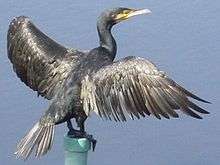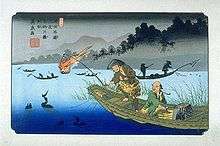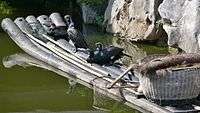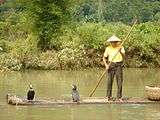Cormorant fishing

Cormorant fishing is a traditional fishing method in which fishermen use trained cormorants to fish in rivers. Historically, cormorant fishing has taken place in Japan and China since about 960 AD.[1] It is described as a method used by the ancient Japanese in the Book of Sui, the official history of the Sui Dynasty of China, completed in 636 AD. This technique has also been used in other countries but is currently under threat in China.[2][3][4]
To control the birds, the fishermen tie a snare near the base of the bird's throat. This prevents the birds from swallowing larger fish, which are held in their throat, but the birds can swallow smaller fish. When a cormorant has caught a fish in its throat, the fisherman brings the bird back to the boat and has the bird spit the fish up. Though cormorant fishing once was a successful industry, its primary use today is to serve the tourism industry.
The types of cormorants used differ based on the location. In Gifu, Japan, the Japanese cormorant (P. capillatus) is used; Chinese fishermen often employ great cormorants (P. carbo).[5] Darters (anhinga), which are very close relatives of cormorants, are also used for this fishing technique on occasion.
Locations

China
In Guilin, China, cormorant birds are famous for fishing on the shallow Lijiang River.[4]
Europe
Cormorant fishing is an old tradition in Greece and Macedonia,[6] especially on Doiran Lake which lies in the border of the two countries, and it is still practiced today by some traditional fishermen. In Western Europe, cormorant fishing took place briefly from the 16th to 17th centuries, primarily in England and France. Though the fishing method was similar to those used in Japan and China, the European method was developed independently and was closely related to falconry.
Japan
Cormorant fishing, called ukai (鵜飼) in Japanese, takes place in 13 cities in Japan. The most famous location is Gifu, Gifu Prefecture, home to cormorant fishing on the Nagara River, which has continued uninterrupted for the past 1,300 years.[7] Cormorant fishing in Seki also takes place on the Nagara River, but it is called "Oze cormorant fishing" (小瀬鵜飼 Oze Ukai). Only the cormorant fishing masters in Gifu and Seki are employed by the emperor and called Imperial Fishermen of the Royal Household Agency.


- Fuefuki, Yamanashi Prefecture (Fuefuki River)
- Gifu, Gifu Prefecture (Nagara River)
- Seki, Gifu Prefecture (Nagara River)
- Inuyama, Aichi Prefecture (Kiso River)
- Uji, Kyoto Prefecture (Uji River)
- Kyoto, Kyoto Prefecture (Ōi River)
- Arida, Wakayama Prefecture (Arida River)
- Miyoshi, Hiroshima Prefecture (Basen River)
- Masuda, Shimane Prefecture (Takatsu River)
- Iwakuni, Yamaguchi Prefecture (Nishiki River)
- Ōzu, Ehime Prefecture (Hiji River)
- Hita, Ōita Prefecture (Mikuma River)
- Asakura, Fukuoka Prefecture (Chikugo River)
Peru
There are records of a form of cormorant fishing taking place in Peru in the 5th century, 100 years earlier than recorded cormorant fishing in Japan.[8][9]
 On the Lijiang River, Yangshuo, China
On the Lijiang River, Yangshuo, China
 In Suzhou, China
In Suzhou, China
See also
References
| Wikimedia Commons has media related to Cormorant fishing. |
- ↑ Jackson, C. E. (1997). "Fishing with cormorants". Archives of Natural History. 24 (2): 189–211. doi:10.3366/anh.1997.24.2.189.
- ↑ Manzi, M.; Coomes, O. T. (2010). "Cormorant Fishing in Southwestern China: A Traditional Fishery Under Siege". Geographical Review. 92 (4): 597. doi:10.1111/j.1931-0846.2002.tb00015.x.
- ↑ Rose, Gerald (1987). The fisherman and the cormorants. London: Bodley Head. ISBN 0-370-31060-8.
- 1 2 "BBC Two - Wild China, Heart of the Dragon, Cormorant fishing".
- ↑ Cormorant Fishing "UKAI". May 2001 version. Retrieved 2008-JAN-30.
- ↑ Macedonian cities - Dojran - macedonia.co.uk
- ↑ Cormorant Fishing on the Nagara River. Gifu City Cormorant Fishing Viewing Boat Office, 2007.
- ↑ Leight, Hermann (1960). Pre-Inca Art and Culture. New York: Orion Press. pp. 49–50.
- ↑ King, Richard J (2013). The Devil's Cormorant: A Natural History. University of New Hampshire Press. p. 7.

